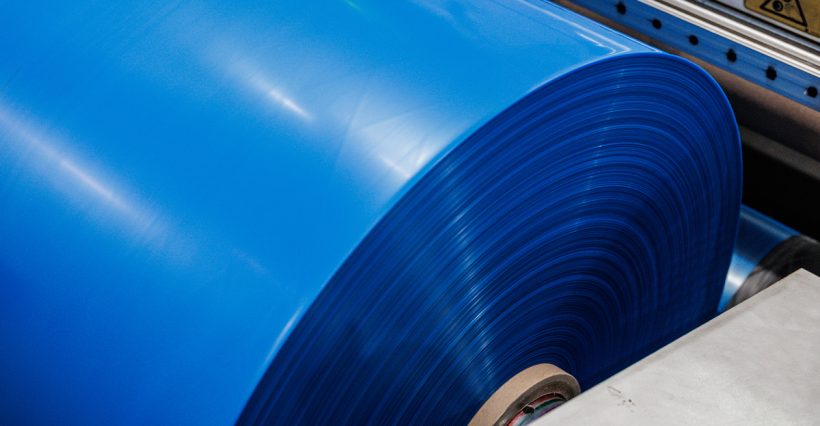Making plastic films such as polyethylene (LDPE and HDPE) antistatic is crucial in sectors where food is automatically packed, among others. In this article, you can read all about static electricity, problems it causes and how KIVO Plastic Packaging solves these problems.
What is static electricity?
Static electricity is the name for the buildup of electric charge on a surface of a poorly conductive material; absorption or release of electrically charged particles takes place, but because no space is provided for an electric current to flow in the material, a voltage difference arises in the material itself, as well as between the material and surrounding surfaces.
The charge contained in the material can be positive or negative. Positive charge results from a shortage of negatively charged particles (electrons), negative charge results from an excess of electrons.
The voltage difference created has a number of adverse consequences for you as a user. We will explain these in more detail later in this article.
When does static electricity occur?
Static electricity is a surface phenomenon and occurs when two or more surfaces come into contact and are separated again. This causes a kind of splitting, or transfer of negative electrons from one surface to another. The level of charge (field strength) depends on several factors: the material and its physical and electrical properties, temperature, humidity, pressure and speed of separation. The higher the pressure or speed of separation, the higher the charge.
That charge can only dissipate once contact is made with an otherwise charged surface (voltage difference). This can be metal, water, but also charged (ionised) air.
What makes plastics so vulnerable to static charge generation?
Most plastics (including polyethylene) are known for their poor conductivity. They have a high so-called surface resistance. The higher the resistance, the more energy is needed for an electron to get through. If the electron does not have enough energy, it stays put and will not move until it finds an exit that offers less resistance.
There are materials with much better conductivity. Copper is a good example. Such materials are used in electrical wires to create a good electric current. Water (moisture) is also a material that conducts current well. We can take advantage of this in some cases. We will come back to this later.
Whether a surface prefers to become positive or negative varies from one material to another. Polyethylene tends to become negatively charged, while air and our skin, for example, become more positively charged upon electron exchange. The greater the difference in electrical preference, the easier the exchange of electrons, the faster the static charge will build up. Air currents in the process are therefore not infrequently the underestimated cause of static charge build-up. In everyday life, static charging of hair (+) while taking off a woollen jumper (-) is a well-known example. In winter, this effect will be worse due to low humidity. After all, water is a good conductor and (dry) air is not.
What is the consequence of static charge?
In principle, no problems should arise. Two poorly conducting surfaces come into contact, exchange some electrons, get static charge, and separate again. As long as that situation would remain like that, it is not a problem. However, the surfaces might come into contact again or come into contact with another material.
With static charge, this basically works the same as with magnetism. Surfaces that have the same charge (- - or ++) repel each other. Surfaces with different polarity (+/-) attract each other.
If either material conducts well, when touched, the electrical charge will flow away. When your skin touches a statically charged surface, it manifests itself by an electric shock. After the shock, the voltage difference is gone and the static charge will be less.
Positively charged film can be thought of as a kind of hoover because of this attraction. It attracts all kinds of swirling around neutral or negatively charged materials from the environment. You can think of dust particles, paper shreds, sawdust, etc.
Because static charge in film can take place very locally, there can also be voltage variation in the film itself arise. This manifests itself, for example, by pasting several successive layers of film together.
If you want to be sure whether a film suffer from static charge, you can test this by blowing the layers apart. If the layers close again after blowing them open, you are probably dealing with static film. Another way is to gently run the back of your hand over the film rubbing. As the downy hairs pass through the film are attracted, there is probably (some form) of static. There are also handy measuring devices to demonstrate this, so-called "electrostatic field meters."
Problems due to static film for you as a user
Static electricity is not only annoying because users of the film can experience annoying electric shocks, it can also cause the problems below:
- Static film can cause dust or other dirt to be attracted to the film; this could compromise food safety.
- Adverse effects during the sealing process due to dirt accumulating where the seal will be applied
- The film can stick together so it does not open easily
- The foil web will behave differently in the machine, or loose bags will not be routed properly in machine further.
- Unsafe situations in environments with flammable or explosive substances; e.g. ink or dust
- In addition, a lot of static electricity shortens the life of costly electronics on, for example, your packaging machines.
What factors affect static film?
- Humidity;
Low humidity reduces conductivity. During the winter months, the air sometimes wants to be dry which can cause an increase in static charge. - Friction in the production process;
Rollers in the machine that have become rough (dirty) or move less smoothly, this can cause extra friction which will increase static electricity. - Air flows in the production process;
Air is an opposite of electric charge. Air wants to become + and film will - become. - Temperature differences;
Temperature differences between production site and a colder storage site can affect the film static charging. Hence, we always advise our customers to use the film keep at least 24h in advance at ambient temperature. - Pretreatment;
Corona treatment of the film may affect static charge.
How to ensure delivered static film antistatic?
Already produced film getting rid of static electricity on their own is complicated. Customers could purchase ionisation bars to remove electrical charge on the film blow during the production process. A simpler solution to the film antistatic is to make the film to degenerate. There may be an earth wire against the film be held to conduct electricity to earth via a metal object. A final, not particularly elegant way with ready-made bags is to bang a bundle of bags on the ground like a mat beater.
Emergency solutions of this kind are not always effective and would not be necessary if the film in principle delivered de-energised.
How does KIVO prevent film is static?
film You can make them antistatic by fitting various ionisation bars in the production process that prevent any build-up of static electricity in the film neutralise. KIVO Flexible Plastics also makes use of this. These beams are frequently maintained to ensure their operation.
In addition, you can film antistatic by using nebulisers that ensure the humidity in the production site remains at an adequate level, safe and healthy. Proper humidity ensures that static electricity build-up is limited.
Furthermore, you can film antistatic by using additives. These additives ensure that the surface resistance of the film is lowered. Lower surface resistance provides better conduction of electrical particles. This ultimately results in lower static training. The electrons need to keep moving to avoid static charge.
Different types of additives
- Fast-acting antistats;
functional 24h after production because they migrate rapidly to the surface of the film. These antistatic agents only work at a certain humidity level. - Permanent antistatics;
Have less tendency to migrate, making them slower and less functional in the short term but longer functional than fast-acting antihistamines. - "Carbon Black" antistatic;
The advantage of this antistatic is that it does not depend on humidity. This is because it does not migrate, it is contained in the film and does not move to the surfaces. For static charge control, this is the best additive. These are applicable in environments with an extremely high risk of explosion and fire. One disadvantage of this additive is that it is black in colour, so aesthetically not an elegant solution. This additive is therefore only used when there is no other option.
Are these additives food safe?
The additives used within KIVO to film antistatic are food-safe. These additives can be added as required to the recipe for the extruding the film.
Questions regarding the prevention of static film?
Do you have any questions as a result of this article or do you have any static concerns of your own film and are you looking for a solution? Then get in touch with one of our experts with no obligation, they will be happy to talk to you.



